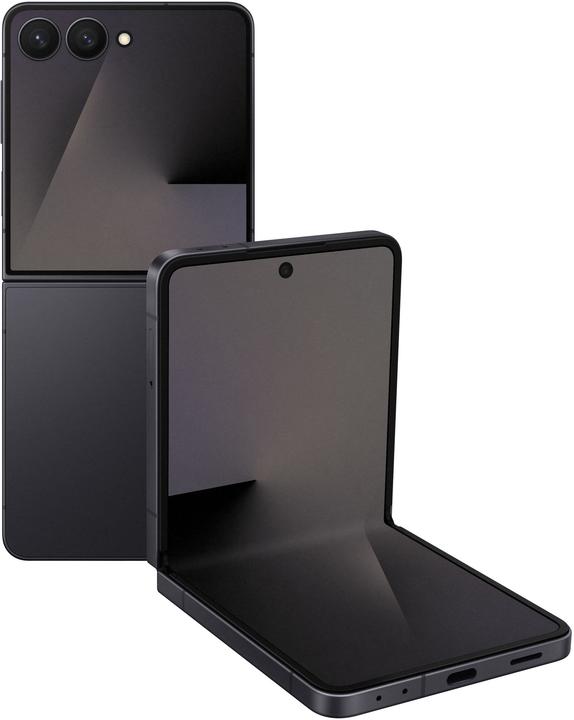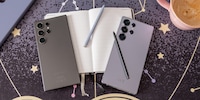
Samsung or Motorola: Which foldable works better?
Foldables are still niche in 2025, but they've become pretty damn good in the meantime. I'll pit the flip top dogs Samsung and Motorola against each other.
My favourite smartphone of 2025: the Motorola Razr 60 Ultra. It's pink, foldable and offers gadgets and cameras on the outside display. Biggest competition: the Samsung Galaxy Z Flip 7, which is also available in pink, foldable and with top cameras. The main differences lie in the details.
For the comparison, I award up to 5 hearts per category to select the folding winner at the end.
Design and external display: Motorola fits well in the hand
Motorola: 💖💖💖💖💖
Samsung: 💖💖💖💖
Both smartphone manufacturers have now managed to install an external display that covers the entire front - apart from the two camera lenses, of course. The dimensions are almost identical (Samsung: 8.5 × 7.5 × 1.4 cm, 188 g; Motorola: 8.8 × 7.4 × 1.6 cm, 199 g). The real difference is only noticeable in the hand.
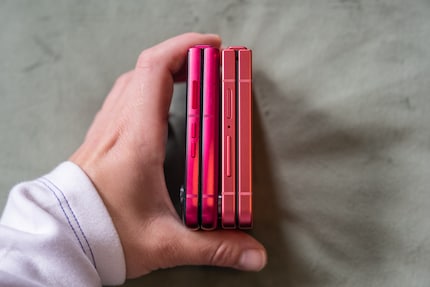
Samsung opts for a somewhat more elegant, angular design. This feels less comfortable in the hand. The edges and display of the Motorola are rounded. Motorola enhances the back with a textile surface that is pleasant to the touch. Samsung has opted for a matt, salmon-coloured surface. I like the overall package of Motorola better in terms of look and feel, but overall I think both are stylish.
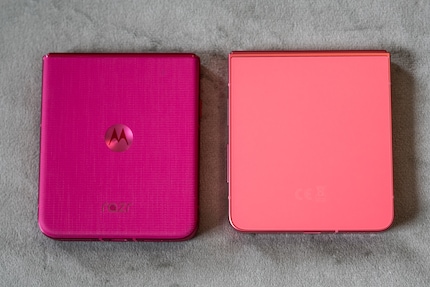
The biggest advantage of the external display: I don't have to open the device. At least with Motorola. Here I can use all the apps throughout and add whatever I want directly. With Samsung, there are severe restrictions - unless I switch to trial mode. I also can't simply add apps, but have to go to the settings on the smartphone. Although not all Motorola apps are perfectly adapted to the screen 100 per cent, I prefer the freedom to try out and use everything. And then there's Motorola's huge selection of mini-games especially for this screen!
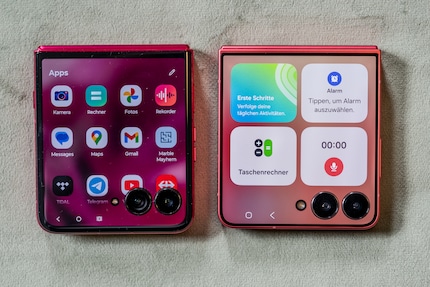
Hinge, fold and inner display: Dustproof is different
Motorola: 💖💖💖💖
Samsung: 💖💖💖
Both are equally well protected against water and dust in accordance with IP48. This means the devices can withstand 30 minutes in 1.5 metres of fresh water. They are also unaffected by dust particles of one millimetre or more. So I prefer to double check whether there are any small crumbs in my trouser pockets before I stow one of the devices in them.
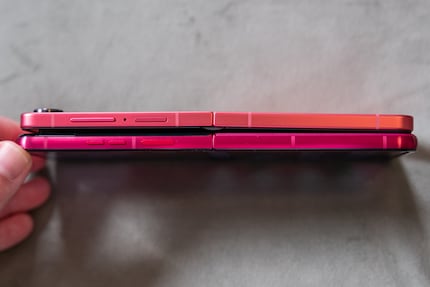
The hinge and flip itself differ in handling. Overall, I find opening and closing them both comfortable and they both feel robust. Samsung's workmanship feels a little more stable, but it is slightly crooked and sounds a little hard when closing. With Motorola, it feels much more comfortable and doesn't snap shut so hard.
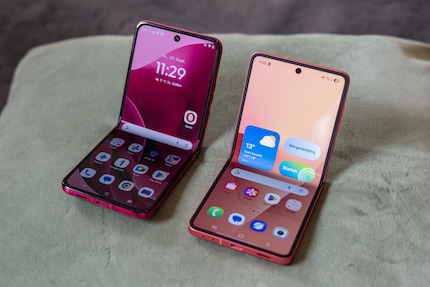
The differences are barely noticeable when the inner display is opened. Both now only show the crease very discreetly when viewed from the front. I can hardly feel the dents either. However, Motorola has installed a slightly better display, even though both measure 6.9 inches. The resolution of 2992 × 1224 pixels is slightly higher than Samsung's 2520 × 1080 pixels and the refresh rate is up to 165 hertz, whereas Samsung's is up to 120 hertz - but even that is more than enough for smooth scrolling. The peak brightness for Motorola is 4500 nits, compared to 2600 for Samsung: 2600 nits is already very bright, but especially with a foldable, a few levels higher are worth their weight in gold.
Overall, there is still room for improvement in terms of dust resistance, but otherwise both are at an extremely high level. The fact that the fold is no longer noticeable at all is unlikely to happen - I estimate this purely physically.
Cameras: either wide-angle or macro
Motorola: 💖💖💖💖
Samsung: 💖💖💖💖
Because of the form factor, both Samsung and Motorola have opted for two camera lenses. In the meantime, smartphones are increasingly being fitted with three cameras. It is interesting to see which lenses the manufacturers have opted for. Both use AI for the zoom to sharpen the images afterwards. I personally find this problematic because it distorts the results too much in some cases. At least Samsung still provides optical magnification at 2x zoom.
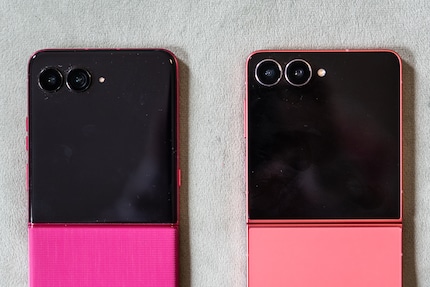
Motorola
- Main camera: 50 MP, 1/1.56", macro mode
- Ultra wide angle: 50 MP
- Selfie camera: 50 MP
Samsung
- Main camera: 50 MP, 1/1.57", 2x optical zoom
- Ultra wide angle: 12 MP, 1/3.2"
- Selfie camera: 10 MP, 1/3.0"
With Motorola, I get a 50 MP main camera and a 50 MP ultra-wide angle - for landscapes, for example. Thanks to macro mode, I can also get very close to objects and still get a sharp image. With Samsung, I also get a 50 MP main camera, but only a 12 MP ultra-wide angle and there is no macro mode at all. In the end, however, the results are the most meaningful.

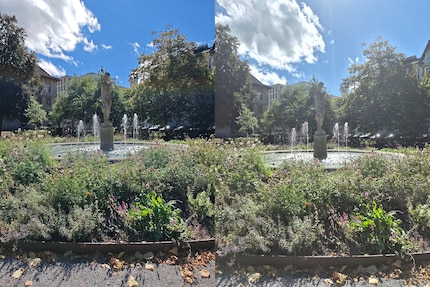
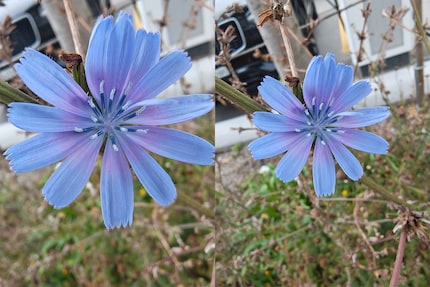
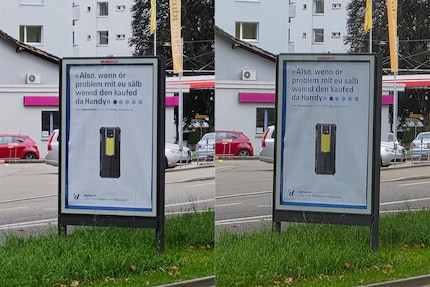
The images on the Samsung are more natural and the dual optical zoom is useful. Motorola's colours are more vibrant and I'm very happy with the macro mode. Overall, I find both results successful, with room for improvement. In everyday life, Motorola lacks a good zoom without AI, so Samsung gets one more heart from me.
The gesture control is practical with both: if I set up the Foldables like a tripod for a photo, I can control the shutter release remotely. I hold up the flat of my hand and the devices immediately switch on a three-second timer and: Zack! Photo is there.
Chip and battery: they both last the day
Motorola: 💖💖💖💖
Samsung:💖💖💖💖
The battery is essential for daily use. Motorola has installed 4700 mAh for this. This lasts up to 20 hours - enough for a full day. The charging time is around 40 minutes for a full charge thanks to 68 watts of TurboPower, and up to 30 watts are possible wirelessly.
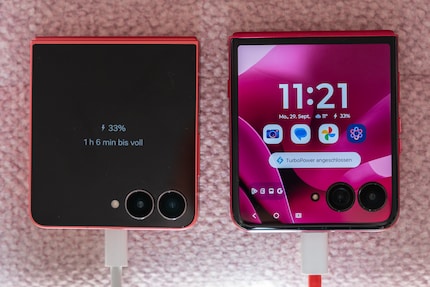
Samsung has a 4300 mAh battery, which also lasts a good 18 hours. The disadvantage: The device can be charged with up to 25 watts wired and 15 watts wirelessly - and that takes a minimum of 1.5 hours. Charging for a few minutes before I leave the house is therefore far less worthwhile here than with Motorola, which charges almost three times as fast.
Not to be underestimated is the centrepiece: the chip. Samsung has installed its own in-house Exynos 2500. Motorola has opted for Qualcomm and uses the Snapdragon 8 Elite. Both deliver comparable results in the benchmarks and can be categorised in the premium class. This means they are powerful enough - both for any smartphone games and surfing as well as for AI tasks.
Software: AI and updates
Motorola: 💖💖💖💖
Samsung:💖💖💖💖
Both smartphones run Android 16 with a customised user interface. With Samsung, however, I get seven years of software and security updates - an industry-leading value. Motorola only offers three years of software and four years of security patches. Since June 2025, smartphone manufacturers in Europe have had to provide at least five years of both for new devices. Motorola will definitely have to do better in the future.
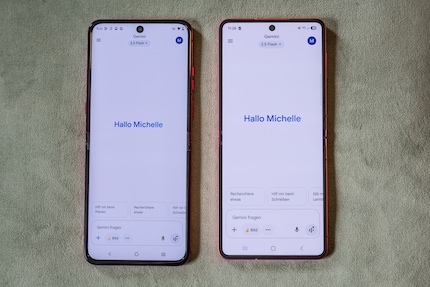
Both Foldables have the Google AI Gemini on board, but each has its own functions. Motorola calls its own AI motoAI and offers the functions directly in an app folder. On the one hand, I find playful things like the Image Studio here: I can generate images, avatars, stickers and wallpapers by prompt. On the other hand, there are also really useful things like «Pay Attention». This function is a recorder for recording conversations. From this, the AI automatically creates a transcript and a summary.
I also find something similar with Samsung's Galaxy AI. From a sketch, for example, the AI creates a picture for me in the desired drawing style - from pencil and watercolour to colourful comic figures. Transcript Assist also creates transcripts and summaries of voice recordings - not automatically, however, but on command.

Generative editing is both practical and good. The AI-supported image editing can move, enlarge, reduce or remove objects and fills the resulting gaps in the background.
Overall, the results are very good with both Motorola and Samsung - but I have to let myself be surprised in each case and can't intervene enough. Samsung's images and texts are a little better in each case.
Evaluation and conclusion: head to head
Motorola has definitely made the most of the form factor. I can use almost all of the smartphone functions on the external display. The camera is also great and delivers colour-intensive images. If I want to be supported by the AI, I am well served with motoAI.
Samsung limits the outdoor display functions somewhat, which I can use, but it works great. The photos are not quite as bright, but provide more detail. The AI functions are also a tad better and directly integrated well into the apps.
In terms of performance and battery, the two foldables are in a close neck-and-neck race. The overall score actually shows a tie with 19 points. The two devices scored an average of 3.8 hearts. A thoroughly good score.
Motorola: 3.8💖
Samsung: 3.8💖
When I buy a foldable myself, I want to benefit from the form factor first and foremost - in other words, I want to use the outdoor display without restrictions. And that's where Motorola wins. The fact that the battery lasts two hours longer and charges much faster is also a decisive advantage in everyday use. That's why the Razr 60 Ultra wins for me.
Here you can find the detailed individual reviews of the Razr 60 Ultra and the Galaxy Z Flip 7.
Motorola Razr 60 Ultra

Samsung Galaxy Z Flip 7
In my world, Super Mario chases Stormtroopers with a unicorn and Harley Quinn mixes cocktails for Eddie and Peter at the beach bar. Wherever I can live out my creativity, my fingers tingle. Or maybe it's because nothing flows through my veins but chocolate, glitter and coffee.
Practical solutions for everyday problems with technology, household hacks and much more.
Show all
